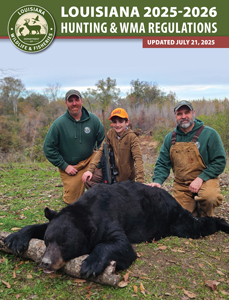Chronic Wasting Disease
2025 Updates: Important Deer Regulation Information
The Louisiana Department of Wildlife and Fisheries continues to monitor and test the state’s white-tailed deer herd for chronic wasting disease (CWD). In 2022, Louisiana became the 29th state to detect CWD. It had been previously detected in Texas, Arkansas and Mississippi.
Transport and Possession Regulations for Deer Being Harvested Out-of-State
Help Prevent The Importation and Spread of Chronic Wasting Disease
Import regulations have been implemented in an effort to reduce the spread of Chronic Wasting Disease (CWD). Louisiana and 43 other states have implemented similar transport regulations in an effort to slow further spread. CWD has been detected in 36 states and five Canadian provinces. Hunters returning to Louisiana can help prevent the spread of CWD by complying with cervid carcass import regulations.
Members of the family Cervidae include but are not limited to white-tailed deer, mule deer, elk, moose, caribou, fallow deer, axis deer, sika deer, red deer, and reindeer.
Approved parts and deboned meat from other states must contain a possession tag with the hunter’s name, out-of-state license number (if required), address, species, date and location (county and state) of harvest. All cervids transported into or through Louisiana that are in violation of the provisions of this ban shall be seized and disposed of in accordance with the Wildlife and Fisheries Commission and Department of Wildlife and Fisheries rules and regulations.
CWD Cervid Carcass Import & Export Regulations
No person shall import, transport or possess any cervid carcass or part of a cervid carcass originating outside of Louisiana, except for
- meat that is cut and wrapped
- meat that has been boned out
- quarters or other portions of meat with no part of the spinal column or head attached
- antlers
- clean skull plates with antlers
- cleaned skulls without tissue attached
- capes
- tanned hides
- finished taxidermy mounts
- cleaned cervid teeth
Louisiana CWD Control Area Regulations
Baiting, placement of bait, or hunting over bait is prohibited within a LDWF designated CWD control area. It is the responsibility of hunters to check their hunting area for bait prior to each hunt. A baited area is an area on which salt, grain, or other feed has been placed, exposed, deposited, distributed, or scattered, if that salt, grain, or other feed could serve as a lure or attractant for wild quadrupeds or wild birds via ingestion. The use of approved bait not normally ingested by deer for feral hog trapping will still be allowed.
The export of any cervid carcass or part of a cervid carcass originating within a LDWF designated CWD control area is prohibited, with the above exceptions. In addition, an exemption for intact deer heads from within the CWD control area transported to Louisiana taxidermists for taxidermy purposes in parishes outside of the CWD control area is allowed by waiver and adherence to waiver guidelines.
More information about CWD control area regulations and a map of the current Louisiana CWD control area is available at: www.wlf.louisiana.gov/page/cwd
What is Chronic Wasting Disease?
CWD is a neurodegenerative disease found in most deer species, including but not limited to white-tailed deer, mule deer, elk, red deer, moose and caribou. It is infectious, always fatal and there is no treatment. It’s part of a group of diseases know as transmissible spongiform encephalopathies (TSEs) and is similar to BSE (mad cow disease) of cattle and scrapie in sheep. These diseases cause irreversible damage to brain tissue which leads to excessive salivation, neurological symptoms, emaciation and death of the animal.
Has It Been Found in Louisiana’s White-Tailed Deer Population?
CWD has been detected in Louisiana. In addition, Arkansas, Mississippi, and Texas have detected it. The disease has been documented in 36 states and five Canadian provinces. LDWF has been monitoring and testing for CWD since 2002 and has tested approximately 21,000 deer.
What Causes CWD and How Is It Spread?
CWD is caused by prions, which are proteins normally found in the body that have mutated. These prions accumulate in the brain and cause holes to develop in brain tissue. While prions are concentrated in the central nervous system, they can be found within other tissues of the infected animal, including muscle.
CWD is spread through direct deer-to-deer contact or through contact with urine, feces, saliva and body parts of infected deer or infectious materials in the soil. Prions will bind to soil particles once an infected deer carcass has decomposed. Once in a location, the disease is present indefinitely.
What Signs Do Deer with Cwd Display?
Prions can be shed within 6 months of infection, but it can take one to two years for CWD to incubate and exhibit outward symptoms in the infected animal. Symptoms include emaciation, lethargy, abnormal behavior, and loss of bodily functions. Other signs include excessive salivation, loss of appetite, progressive weight loss, excessive thirst and urination, teeth grinding and drooping ears.
Can Humans Contract CWD?
According to the Centers for Disease Control and Prevention (CDC) there is no evidence that CWD can infect humans. However, the CDC recommends caution in handling venison in the infected region and that deer be tested for CWD before consuming. CWD positive deer should not be consumed by people.
How Can I Report a Suspect Deer?
You can assist LDWF in disease surveillance by reporting any deer that exhibits CWD symptoms. Suspect deer should be reported to the nearest LDWF field office.
For more information: www.wlf.la.gov/page/cwd

